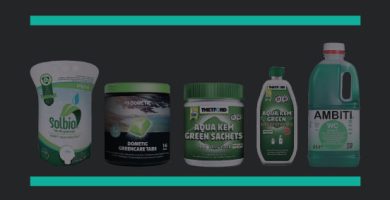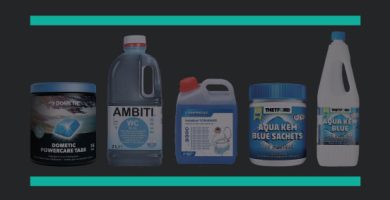Do you want to know what are the best cleaning products for the potti? In this post we bring you a lot of information that will help you choose the right products so you don’t have unpleasant odors inside your vehicle Let’s get to it!
Comparison of the best products for the waste tank of a portable wc
The following items are the right ones to use in the potty waste tank. These products help to break down the waste to a liquid state and prevent bad odors.










What types of products are there for chemical toilets or potti?
The camper world already has its own jargon with a lot of colloquial terms that we use so often that sometimes we forget that many people do not have to know them. With potty products, we talk about blue, green and pink liquid, but what is each one used for?
Do you know how to properly maintain the chemical toilet or potty so that it lasts for years without odors?
The potty has certain elements that over time wear out and stop doing their job properly, which can cause a huge mess inside our van. Don’t miss the following tips to avoid a nasty spill or even a flood due to a bad potty maintenance.
1. Keep the rubber or silicone parts in good condition
All potties have a valve through which the waste has to pass to reach the waste tank. This lid has a silicone surface which, when in good condition, serves to seal the waste tank, preventing bacteria and bad odors from escaping to the outside.
To keep the valve, and the rest of the rubber gaskets, elastic and lubricated, use a silicone spray such as Thetford’s seal lubricant. Also, if you find that the valve does not open as smoothly as it used to, it might be a good idea to put some on it, as it is possible that it is due to a lack of lubrication.
2. Clean the Potti’s black water tank thoroughly
It is advisable to deep clean the chemical toilet tank 2 or 3 times a year, depending on the intensity of use, with a suitable product such as Thetford Duo Tank Cleaner. This helps to remove sediment and debris that may be embedded in the tank. All you have to do is add the recommended amounts of product (200ml) and warm water (5l) directly into the tank and shake it for a while and leave it to act for about 16 hours. Once this time has elapsed, you only have to clean the tank without the need to shake it.
It is also advisable to do this cleaning with the grey water tank. You can take advantage and do it at the same time. Read the manufacturer’s instructions for a correct dosage.
3. Clean the potty in depth when you are not going to use it
If the potty is not going to be used for some time, it is advisable to clean it thoroughly, dry it well and leave it with the valve open. This way the silicone of the valve will not tend to dry out and the waste tank will have an air duct.
The same with the cistern, it is better to leave the lid open to avoid any humidity that could cause mold and bad odors.
How to avoid bad odors from the potty
Over time, the rubber gaskets that seal the valve that separates the bowl from the tank may deteriorate and may not be able to retain odors 100%. If this is happening to you, after you finish flushing, flush the toilet and close the valve, pour a little water over the valve. This layer of water will neutralize any odors that may escape through the waste tank lid.
Final thoughts on portable toilet products and pricing
The Potti is an essential element in many camper vans, but if you want a good user experience you will have to dedicate some care and periodic maintenance to, among other things, avoid deterioration and bad odors.
As you may have read, there is a wide variety of brands that offer products for very different uses (to break down waste, for the tank, for cleaning, etc.), with very different characteristics (chemical, ecological, etc.), in different formats (liquid, tablets, water-soluble single doses, etc.) and at competitive prices.
We personally are using right now a 100% organic and ecological product.
- In the waste tank: Promotes the decomposition of waste and toilet paper, preventing the formation of gases and bad odors. Dosage: 1 pack per 40 gallons.
- In the tank: Prevents the accumulation of deposits and algae and keeps the water clean and fresh. Dosage: 1 pack per 40 gallons.
- Pre-packaged portion control – no measuring or pouring.
Frequently asked questions about the camper wc
These are some of the questions that we have been asked or that we have seen users often ask. If you have any questions, feel free to ask, we are happy to help ☺️
It is important to use the products recommended by the manufacturers of portable toilets, especially those that treat the waste tank. See our post on potty care to learn about the products, tricks and maintenance needed to prevent the potty from smelling bad.
The portable toilet is not designed like the toilet in our home that is connected to a sewage system. The waste (urine or fecal waste) is stored in the waste tank and must be properly treated to help its decomposition and avoid bad odors in our vehicle.
Two or three times a year it is recommended that we do a thorough cleaning to our potty. For this purpose, there are products from Thetford and other brands, which are designed to leave the potty as good as new. Basically they eliminate all traces of bacteria, lime and other residues favoring the useful life of the toilet.
As a general rule, the tank should be emptied every 3 to 5 days, bearing in mind that this may vary according to the product you use, the intensity of use of the toilet and the ambient temperature. It should also be emptied when the indicator, if present, indicates that the tank is full. In this case it would be best to empty it as soon as possible to avoid possible spills while on the move. Another situation in which it is important to empty the potty is if it is not going to be used for a long time.
No, it is not at all advisable to use bleach in our chemical toilet. Although bleach is a great cleaning product, it can damage the potty, causing in the long run a malfunction of the potty. There is a great variety of products for potty, our recommendation is to make use of them.
The red or pink liquids are for the potti tank while the blue liquids are added to the waste tank and serve to accelerate the decomposition of organic waste and toilet paper.
Both blue and green products and liquids are to be added to the waste tank and aid in the decomposition of waste. The difference is that the green ones are usually an environmentally friendly alternative to the blue ones.



